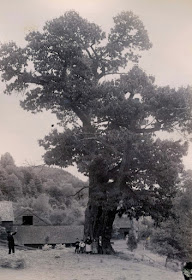Chestnut trees have been part of agriculture for centuries, native to Asia, North America, and Europe. The American Chestnut trees dominated forests in the American Northeast and Appalacia, some eliciting the same sense of awe and wonder of the West coast's redwoods. The trees were the keystone species, providing nuts for wildlife and humans. Our generation does not remember them, because they were wiped out by chestnut blight during the first half of the 20th century. Of the billions of trees that died, a few appeared to have genetic resistance to chestnut blight, and are part of the source for new trees being planted to begin restoration of the species. Sources of new strains of blight resistant, or blight tolerant, chestnut trees include, progeny of the American chestnut trees that survived; hybrids with resistant Asian species, and their progeny via selected breeding, and genetic engineering. There is also a virus disease that attacks the blight fungus, and may prove helpful.
In addition to the American Chestnut (Castanea dentata) There are 8 or 9 species, including species from Europe (
Castanea sativa), Japan and South Korea (
Castanea crenata), and several from China as well as other American species. Only the Asian species, which evolved in association with chestnut blight, are widely resistant to the disease. Some species of chestnut make for trees in much smaller sizes, compared to American chestnut, although there are exceptions, including the massive millenia-old "One Hundred Horse Chestnut Tree" on Sicily, which is not a horse chestnut but rather a chestnut tree that could shelter horses. The European and Asian chestnuts have larger nuts, compared to American chestnut, but the American chestnut is reported to have the best flavor.
As a food crop, chestnuts are more like a grain, or potato, compared to most other nuts. That comparison is based on flavor and the much higher amount of carbohydrates, with much less fat and protein. Depending on the variety,
they are starchy, sweet, and a good source of carbohydrates. Chestnuts are rich in folic acid, minerals, and mono-unsaturated fats. Because they were lost to the American psyche, we don't have a lot of tradition with chestnuts in our diet, but in Asia and Europe chestnuts are a staple. Chinese chestnuts are making a foray into the European market
after European chestnuts trees are also seeing damage from a predatory wasp, also from Asia.
US chestnut production is only 1% of world production, but may grow as Americans learn to enjoy them. One barrier is that chestnuts don't keep as well as other nuts, lose flavor or develop off flavor in storage. Therefore, like many foods, home grown or local chestnuts are more likely to taste best.
 |
| Image source: Vintageprintable.com |
After I cleared a few thousand feet of blackberry brambles from my property, I was left with a significant amount of barren soil. I've broadcast grass seed to hold soil and allow mowing, to prevent return of blackberries. However, this area is ideal for addition of potentially large - growing trees. I wanted trees that might bear in my lifetime, preferably within 5 years. It's said that we plant trees for those who follow, but my experience is that a lot of people just love cutting trees down, so I want to experience some of what I plant regardless of what future people do.
Walnuts, butternuts, hickories, pecans may all produce nuts here, but take longer to bear, compared to chestnuts. Filberts bear younger, have more compact, bushy trees. I have a few filbert trees, including some wild ones near the cleared area.
With a permaculture bent, I decided to add some chestnut trees. Grafted hybrids may start bearing in 3 to 5 years, and seedlings may start bearing a few years later. They are fast growing. I did not see estimates of growth per year, but I suspect in the more than three foot-per-year category, similar to some maples. I've had some maples put on 5 feet in a year, so possibly that much.
I already reviewed some considerations in a post yesterday, but here are some again, and some additional thoughts.
1.
At least two different pollen-bearing varieties are needed, if you want chestnuts. They can not be the same variety. Each will provide pollen for the other.
2.
Watch for pollen-sterile or pollen-free varieties, which will not pollenize another tree. OK if they are just a shade tree, or if you have several varieties. But I would not plant one as one of a pair.
3.
Chestnut trees are large, in the shade tree category. Websites generally state they need to be
at least 20 feet apart, some stating 30 feet, but no more than 50 to 100 feet from the nearest pollen producing chestnut. I would not worry about the redwood size trees in photos. Most modern ones will never grow any where near that big, although some of the newer American chestnut trees might one day rival their ancestors.
4. Even in blight free areas, there is risk for future blight infestation. I prefer
choosing disease resistant cultivars for what protection can be given for future generations. Most will either be an Asian species or hybrid with Asian species
5.
Grafted varieties will bear sooner, and are more predictable as far a s quality, compared to seedlings. Since these are a long-term commitment, I think it's wise for the average person to invest in the grafted varieties for your pair of trees, then possibly a seedling if you want another wild card tree.
6.
Deer and rodents can kill the young trees, same as for many other species. They will need a vole-sleeve of hardware cloth for a few years, and a deer cage until too tall for deer browsing.
Possibly one day I will be able to follow up this blog post with photos of my growing trees, and later with photos and descriptions of the chestnuts.

































